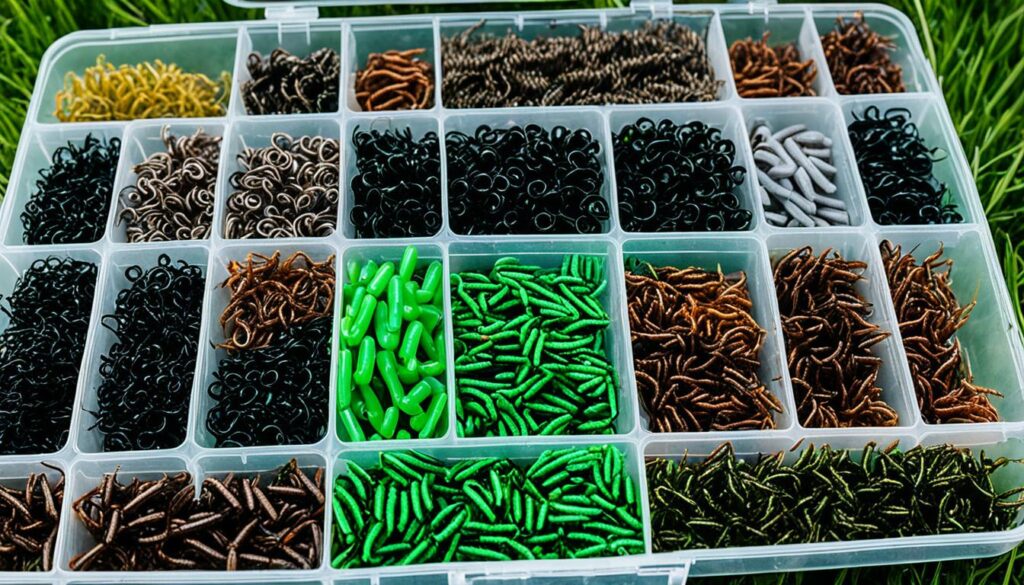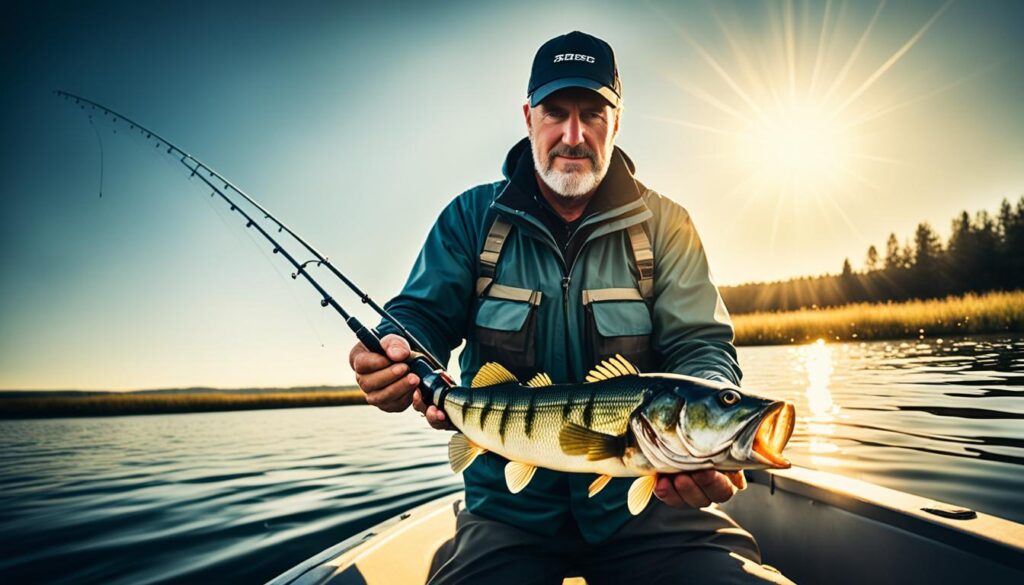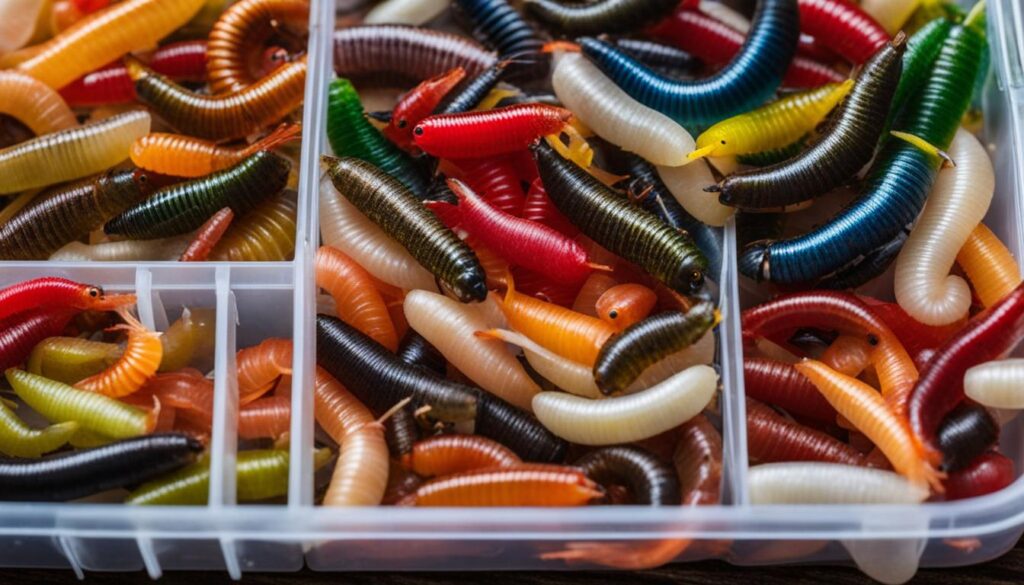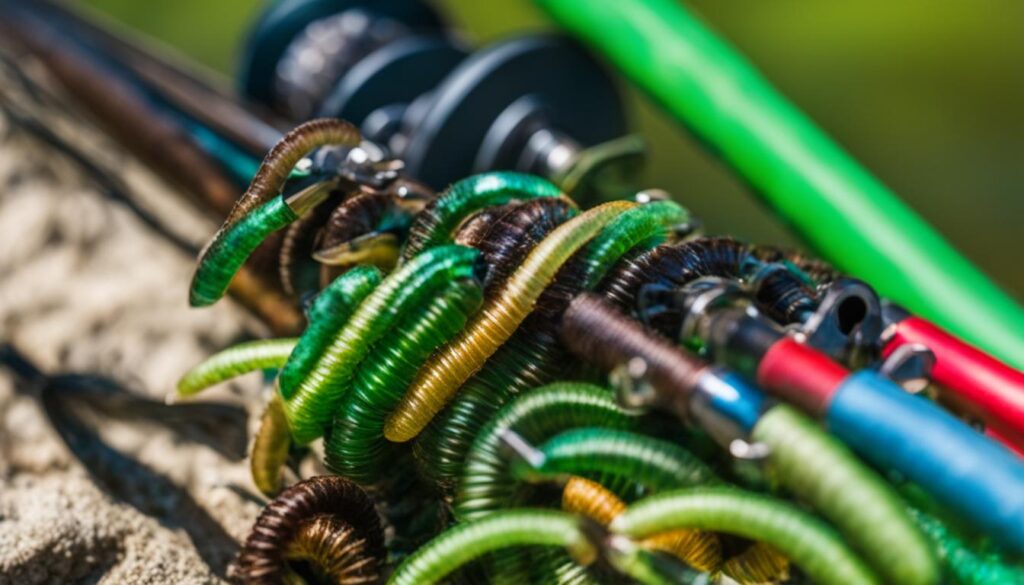For summer bass fishing, soft plastic worms like the Strike King Rage Tail Cut-R Worm Bait and Strike King Rage Tail Anaconda can significantly increase your chances of catching bigger fish. These versatile fishing lures are highly effective in enticing bass to bite, thanks to their realistic appearance and natural movement in the water. With the proper techniques and bait selection, you can unlock the secrets of summer bass fishing and enjoy a successful and rewarding fishing experience.
Best Soft Plastic Worms for BIG Summer Bass
| Fishing Condition | Recommended Worm | Technique/Details |
| Early Summer Ledges | Zoom Ol’ Monster | To attract bass in deeper water, use a giant ribbon-tail worm with a larger profile. Pair it with the appropriate weight for the desired depth. |
| Late Summer Cover | Zoom Mag II | Use smaller ribbon-tail worms around brush piles and stumps for a more enticing presentation in deep cover. |
| Shaky Head & Drop Shot | Straight-tail worms | Perfect for finesse techniques, these worms have subtle action to tempt finicky bass. |
| Hopping Presentations | Vibe worms | Worms with paddle-like tails create a thumping vibration underwater, mimicking prey and triggering aggressive responses. |
| Rocking Pressured Bass | Big straight tails or stick baits | Use bulkier worms to attract heavily pressured bass less willing to bite. |
Benefits of Using Soft Plastic Worms

Soft plastic worms offer several advantages when catching more giant bass during summer:
- Realistic appearance and natural movement attract bass
- Versatile for different fishing conditions and cover types (submerged grass, weed edges, brush piles, rocky areas)
- Mimic natural prey with lifelike action
- Can be rigged in various ways (Texas-rig, Carolina-rig, drop shot)
- Durable, reusable, no refrigeration needed
- Wide range of sizes, colors, and scents to match bass preferences
Using soft plastic worms increases your chances of landing trophy bass in summer with their lifelike performance and versatility.
Tips for Successful Summer Bass Fishing with Soft Plastic Worms
- Target areas where bass hold in summer (submerged grass, weed edges, brush piles, deep timber)
- Vary presentations based on fish behavior and cover (dragging, hopping, pausing)
- Experiment with different colors and sizes to find what bass prefer
- Be patient and persistent; trial and error may be needed
Understanding bass behavior and adapting your approach with soft plastic worms will increase your chances of a rewarding summer bass fishing experience and catching giant bass.
Techniques for Fishing with Soft Plastic Worms
Get ready for an adrenaline-pumping bass fishing experience! By mastering various techniques for using soft plastic worms, you can dramatically boost your chances of reeling in some impressive bass. Get ready to take your fishing game to the next level! Whether you’re a beginner or an experienced angler, these expert-recommended methods will make your fishing trips more rewarding. Here are some techniques suggested by professional anglers Todd Faircloth and Terry Bolton:
Techniques by Todd Faircloth
| Technique | Description | Best for |
| Dragging | Cast your worm and let it settle on the bottom. Slowly and steadily retrieve it by dragging along the bottom. | Bass in a sluggish feeding mode |
| Hopping | Cast past your target area and let the worm sink to the bottom. Lift the worm off the bottom with subtle wrist movements, then let it settle back down. Repeat. | Actively feeding bass |
Techniques by Terry Bolton
| Technique | Description | Best for |
| Shaky Head Worms | Cast near cover or structure and let the worm sink to the bottom. Slowly drag the worm, pausing intermittently to entice bass to strike. | Cover or structure fishing |
| Drop Shot Worms | Cast to the desired location and let it sink. Gently lift the rod tip, dragging the worm along the bottom. Pause periodically to mimic a wounded baitfish. | Mimicking vulnerable prey |
Both anglers emphasize the importance of experimenting with different retrieves and adjusting weight sizes for optimal results. Bass can exhibit various feeding behaviors, so adapting your techniques accordingly is crucial for triggering their predatory instincts.
Summary
Fishing with soft plastic worms is a versatile and effective way to target bass. By learning and practicing these techniques from experts Todd Faircloth and Terry Bolton, you’ll be well-equipped to entice bass bites and increase your chances of a successful fishing trip.

Selecting the Right Tackle for Summer Plastic Worm Fishing
Choosing the correct terminal tackle is essential for success when fishing with bass worms. Todd Faircloth and Terry Bolton recommend using hooks sized 5/0 or larger, with an offset bend, extra-wide gap, or straight shank based on personal preference. Ensure the hook has a sufficient gap for good penetration when setting it.
Consider the sinker weight based on the worm’s size, weight, and desired sinking speed. For smaller worms, use fluorocarbon or monofilament lines; for larger worms, braided lines are recommended.
Key Points:
- Hooks: Size 5/0 or larger with an offset bend, extra-wide gap, or straight shank.
- Sinker Weight: Adjust based on worm size and desired sinking speed.
- Fishing Line: Fluorocarbon or monofilament for smaller worms, braided for larger worms.
Selecting the correct terminal tackle ensures proper hook penetration, optimal sinking speed, and effective worm presentation. Tailoring your tackle to specific conditions increases your chances of landing more bass.
| Worm Size | Suggested Weight Range |
|---|---|
| 4 to 6 inches | 1/8 to 1/4 ounce |
| 6 to 8 inches | 3/16 to 3/8 ounce |
| 8 to 10 inches | 1/4 to 1/2 ounce |
When fishing with plastic worms during the summer, using the correct tackle is essential for maximizing your chances of success. As professional angler Terry Bolton advises, selecting the appropriate gear can significantly impact your fishing experience.
He recommends using a 7-foot medium-heavy rod for optimal performance for baitcasting gear. This rod provides the necessary strength to handle big bass and offers excellent sensitivity for detecting bites.
On the other hand, if you prefer spinning gear, a 7-foot medium power rod is the way to go. This lighter rod allows for greater precision and finesse when fishing with worms.
To complement your rod, Bolton highly recommends using a high-speed baitcasting reel. The fast retrieval speed of this reel enables you to quickly take up the slack and maintain control over your bait, making it easier to entice bass into biting.
When choosing the right color for bass worms, various options can increase your chances of success on the water. While the profile and location of the worm are more critical factors, selecting the right color can make a difference in attracting bass. Here are some popular color choices among anglers:
- Black worms with blue tails: This color combination provides a striking contrast that can grab the bass’s attention in various fishing locations.
- Watermelon: A versatile color that imitates various natural baitfish and works well in clear and stained water conditions.
- Green pumpkin: A natural color choice that blends in with many underwater environments, making it a reliable option for fooling bass.
While these colors are commonly used and proven effective, it’s important to note that specific color preferences can vary depending on regional fishing conditions. For example, plum, red bug, and Junebug are favored colors in certain areas.
Some anglers also use additional techniques to enhance the visibility of their worms in the water. Dipping the worm’s tail in dye or using a chartreuse marking pen can create added color contrast and increase the worm’s visibility underwater, making it more enticing to bass.
Size Considerations for Bass Worms

The size of the plastic worm is an important factor to consider when targeting bass. While there is no definitive rule for the perfect size, it is generally recommended to use worms in the 10-inch range. This size has proven effective in attracting bigger bass and increasing the chances of a successful catch.
However, it’s important to note that larger worms may pose some challenges. The increased amount of plastic that the fish needs to take in before reaching the hook can result in a decrease in hookup percentage. Additionally, casting accuracy may be more difficult, especially in windy conditions.
To find the right balance between size and effectiveness, it’s advisable to consider the specific fishing conditions and adapt accordingly. If targeting smaller bass or experiencing difficulties with casting accuracy, opting for slightly smaller worms within the 8 to 9-inch range can still yield positive results.
| Size | Advantages | Considerations |
|---|---|---|
| 10-inch | Attracts bigger bass | Potential decrease in hookup percentage Challenging to cast accurately in windy conditions |
| 8 to 9-inch | Effective for smaller bass Easier casting accuracy | Potential decrease in size of attracted bass |
Conclusion
Soft plastic worms are a game-changer when it comes to summer bass fishing. These versatile lures allow anglers to adapt to different fishing conditions and cover types. By implementing the proper techniques, selecting the appropriate terminal tackle, and choosing the best bait, anglers can significantly increase their chances of catching giant bass.
Whether you prefer using Texas-rigged worms, drop shot techniques or shaky heads; soft plastic worms will surely deliver impressive results. They mimic the natural movement of real worms in the water, making them irresistible to bass. By following the tips and recommendations shared by professional anglers, you can unlock the secrets of summer bass fishing and enjoy a rewarding and successful fishing experience.
Remember that the key to successful bass fishing with soft plastic worms lies in identifying the right fishing spots, experimenting with various retrieves, and adjusting your bait selection based on the fish’s behavior. Feel free to try different colors and sizes until you find what works best on any given day. You’ll conquer the summer bass season and reel in your biggest catch with patience and persistence!
FAQ
What makes soft plastic worms effective for catching bigger bass during the summer months?
Soft plastic worms have a realistic appearance and natural movement in the water, which makes them highly enticing to bass. They can be used in various fishing conditions and cover types, making them versatile and adaptable.
What are some recommended soft plastic worms for summer bass fishing?
Professional angler Todd Faircloth recommends using Texas-rigged worms like the Strike King Cut-R Worm for outside weed edges and deep timber, and the Strike King Anaconda for brush piles. Terry Bolton suggests using big ribbon-tail worms like the Zoom Ol’ Monster for early summer ledges and smaller ribbon-tail worms like the Zoom Mag II for late summer cover.
What are some techniques for fishing with soft plastic worms?
Techniques include dragging the worm along the bottom, hopping it, flipping and pitching around grass lines, and using dragging, pausing, and hopping techniques with shaky head and drop shot worms.
What terminal tackle is recommended for bass worms?
It is recommended to use hooks with a size of 5/0 or larger, with an offset bend, extra-wide gap, or straight shank. The choice of sinker weight should also be considered, and fluoro and mono lines are suitable for smaller worms, while braided lines are recommended for larger worms.
What are some popular color choices for bass worms?
Black worms with blue tails, watermelon, and green pumpkin are commonly used colors. Plum, red bug, and junebug are regional favorites. Some anglers also use dipping dye or a chartreuse marking pen to add color to the tail for increased visibility.
What size of plastic worm is recommended for catching bass?
There is no definite size that is considered too big, but it is generally recommended to use worms in the 10-inch range. Larger worms can attract bigger bass, but there may be a decrease in hookup percentage and challenges in casting accurately.
What tackle is recommended for summer worm fishing?
Terry Bolton suggests a 7-foot medium-heavy rod for baitcasting gear and a 7-foot medium power rod for spinning applications. A high-speed baitcasting reel is recommended, along with the appropriate weight for the worm based on the desired sinking speed and depth being fished.
What are the benefits of using soft plastic worms?
Soft plastic worms have a realistic appearance, natural movement, and durability. Their versatility allows anglers to adapt to different fishing conditions and cover types. They also offer various scent options, making them highly attractive to bass.
What are some tips for successful summer bass fishing with soft plastic worms?
Target areas where bass are likely to be holding, vary your presentation techniques based on fish behavior and cover type, and experiment with retrieves. Also, try different colors and sizes of worms to see what the bass are most responsive to.
How can soft plastic worms help anglers catch bigger bass during the summer season?
Soft plastic worms have a realistic appearance, natural movement, and versatility, making them highly effective in enticing bass to bite. By following the tips and recommendations from professional anglers, anglers can increase their chances of landing bigger bass during the summer fishing season.
